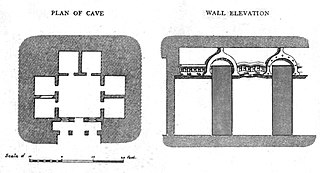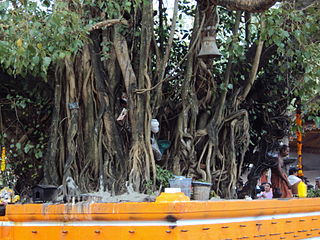
Haridwar is a city and municipal corporation in the Haridwar district of Uttarakhand, India. With a population of 228,832 in 2011, it is the second-largest city in the state and the largest in the district.
Indian culture is the heritage of social norms and technologies that originated in or are associated with the ethno-linguistically diverse India. The term also applies beyond India to countries and cultures whose histories are strongly connected to India by immigration, colonisation, or influence, particularly in South Asia and Southeast Asia. India's languages, religions, dance, music, architecture, food and customs differ from place to place within the country.
South Indian culture refers to the culture of the South Indian states of Tamil Nadu, Karnataka, Kerala, Andhra Pradesh, and Telangana. South Indian culture, though with its visible differences, forms an important part of the Indian culture. The South Indian Culture is essentially the celebration of the eternal universe through the celebration of the beauty of the body and femininity. It is exemplified through its dance, clothing, and sculptures.

Vihāra generally refers to a Buddhist monastery for Buddhist renunciates, mostly in the Indian subcontinent. The concept is ancient and in early Sanskrit and Pali texts, it meant any arrangement of space or facilities for dwellings. The term evolved into an architectural concept wherein it refers to living quarters for monks with an open shared space or courtyard, particularly in Buddhism. The term is also found in Ajivika, Hindu and Jain monastic literature, usually referring to temporary refuge for wandering monks or nuns during the annual Indian monsoons. In modern Jainism, the monks continue to wander from town to town except during the rainy season (Chaturmas), and the term "vihara" refers to their wanderings.

Thekkady(Idukki district) is a town near Periyar National Park, an important tourist attraction in the Kerala state of India. The name Thekkady is derived from the word "thekku" which means teak. Temperatures are lowest in the months of December–January and highest in the months of April–May.

Sultan Bathery is a town and municipality in Wayanad district of Kerala, India, near the borders with Tamil Nadu and Karnataka states. The largest town in Wayanad district, it is the headquarters of Sultan Bathery taluk.
Edakkad is part of the Kannur Municipal Corporation in Kannur District of Kerala state, in India.
Palampur is a hill station and a municipal corporation situated in the Kangra District in the Indian state of Himachal Pradesh. It is surrounded by pine forests and flanked by the Dhauladhar ranges. There are numerous streams flowing from the mountains to the plains, from Palampur. The combination of greenery, snowclad mountains and water gives Palampur a distinctive look.

Oachira Temple is an ancient temple located in Oachira in Kollam district in the South Indian state of Kerala. According to the Puranas, this temple is one of the famous sacred places of Kerala and India. Oachira is on the border of Kollam and Allappuzha districts, next to the National Highway 66. This temple is known "DakshinaKashi"(SouthaKashi).This very ancient pilgrimage center is centered on the ParaBrahma temple, and covers thirty-six acres of land.

Balligavi a town in Shikaripura taluk Shivamogga district of Karnataka state, India, is today known as Belagami or Balagame. Its ancient names are Baligrama, Dakshina Kedara, Valliggame and Valligrame. Dakshina Kedara means Kedarnath of the South. A place of antiquity, it is known for its ancient monuments. Balligavi is located 72 km from Shivamogga city and 21 km from Shikaripura town and 2.3 km from Shiralakoppa in Shikaripura taluk. Balli in Kannada means creeper or vine.
Kummanam is a village that lies on either side of river Meenachil. Administratively it is in Thiruvarpu and Aymanam Gramapanchayat of Kottayam district in Kerala State, India. Capital town of Kottayam District is 4 km east from here. A bridge named Thazhathangadi palam connects either areas beside river. Kummanam is near the tourist road from Kumarakom to Thekkady.
Devdaha is a municipality in Rupandehi District of Nepal, the ancient capital of Koliya Kingdom, located 7 km east of Lumbini and east of Butwal and shares a border with Nawalparasi district on the east side. It is identified as the maternal home of Queen Mayadevi, Prajapati Gautami and Princess Yasodhara. There are many places to visit in Devdaha. It is believed that Prince Siddhartha had spent some years of his childhood with his step-mother/aunt Prajapati Gautami in Devdaha.

Situated in the northern part of India, bordering with the capital of India New Delhi, Uttar Pradesh is one of the most popular and an established tourist destination for both Indians and non-Indians alike in India. The most populous state of India, Uttar Pradesh contains many historical monuments and places of religious significance. Geographically, Uttar Pradesh is very diverse, with Himalayan foothills in the extreme north and the Gangetic Plain in the centre. It is also home of India's most visited sites, Hinduism's holiest city, Varanasi. Kumbh city, Prayagraj. Kathak, one of the eight forms of Indian classical dances, originated from Uttar Pradesh. Uttar Pradesh is at the heart of India, hence it is also known as The Heartland of India. Cuisine of Uttar Pradesh like Awadhi cuisine, Mughlai cuisine, Kumauni cuisine are very famous not only in India but also many places abroad and Pratapgarh is also famous for Rajputana.

Puliyoor is a village in Chengannur municipality in Alappuzha district in the Indian state of Kerala.
There are places of worship considered important in the Kannur district. Kannur District is one of the 14 districts in the state of Kerala, India. The town of Kannur is the district headquarters, and gives the district its name.

Tamil Nadu has the largest tourism industry in India with a percentage share of 21.31% and 21.86% of domestic and foreign tourist visits in the country. According to the 2020 Ministry of Tourism report, the number of domestic arrivals was at 494.8 million making the state the second most popular tourist destination in the country, and foreign arrivals numbered 6.86 million, the highest in the country, making it the most popular state for tourism in the country.

Parihaspora or Parihaspur or Paraspore or Paraspur was a small town 22 kilometres (14 mi) northwest of Srinagar in the Kashmir Valley. It was built on a plateau above the Jhelum River. It was built by Lalitaditya Muktapida (695–731) and served as the capital of Kashmir during his reign.

Northeast India consists of the eight states Arunachal Pradesh, Assam, Manipur, Meghalaya, Mizoram, Nagaland, Sikkim and Tripura. Tourism in this area is based around the unique Himalayan landscape and culture distinct from the rest of India.
Walur is a major village in Sailu taluka of Parbhani district in Maharashtra state of India. Walur is also famous for ancient valmiki rishi temple placed in center of the village. There are some unconfirmed stories/ truths about the presence of valmiki rishi in walur. The stories states that before being known as valmiki rishi he was not aware of his abilities of writing and was not a devotee of lord RAMA. As guided by narada, valmiki started chanting word 'MARA' and after few years the word turned out as 'RAMA'. Huge anthills formed around valmiki rishi and then he got name of VALMIKI. The unconfirmed stories from this area states valmiki rishi chanted the name of RAMA in Walur and anthill formed around him. As anthill means warul in marathi language the name of village was inspired by it. Before some year the name warul turned out as Walur.

Tourism in India is economically important and ever growing. The World Travel & Tourism Council calculated that tourism generated ₹14.02 lakh crore (US$180 billion) or 9.6% of the nation's GDP in 2016 and supported 40.343 million jobs, 9.3% of its total employment. The sector is predicted to grow at an annual rate of 6.8% to ₹28.49 lakh crore (US$360 billion) by 2027. Various states and union territories of India attract tourists from all over the world, mainly due to the cultural diversity.














